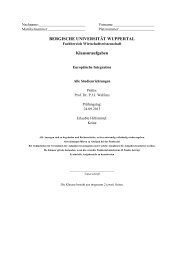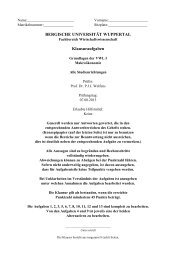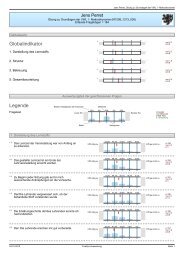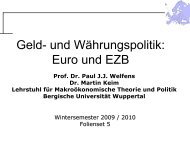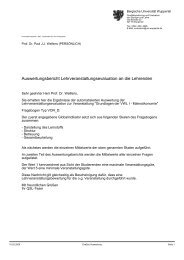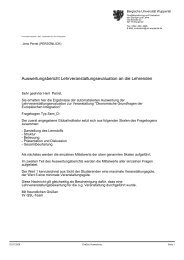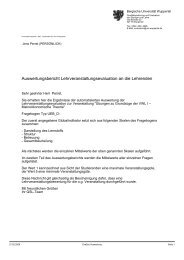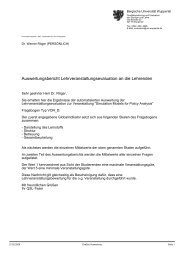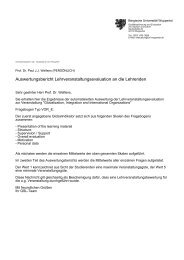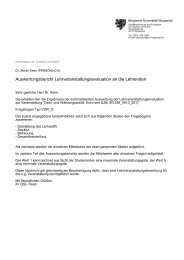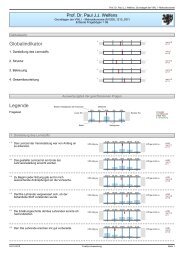UNIVERSITÄT POTSDAM - Prof. Dr. Paul JJ Welfens
UNIVERSITÄT POTSDAM - Prof. Dr. Paul JJ Welfens
UNIVERSITÄT POTSDAM - Prof. Dr. Paul JJ Welfens
You also want an ePaper? Increase the reach of your titles
YUMPU automatically turns print PDFs into web optimized ePapers that Google loves.
There is no doubt that the Maastricht convergence process has reduced economic<br />
growth since prior to the start of the euro and the ECB in 1999 many countries,<br />
including Italy, Germany, France and Spain had to reduce government-GDP ratios in<br />
order to reduce deficit-GDP ratios and subsequently excessive debt-GDP ratios. Germany,<br />
Spain and France were close to the 60% maximum for the debt-GDP requirement<br />
in 2000; among the large EU countries only Italy still had an excessive debt with<br />
110.7% of GDP – but well below the peak ratio of 123.9% in 1994. While the Maastricht<br />
convergence process required fiscal retrenchment in some countries it also is true<br />
that downward interest rate convergence brought a reduction of the interest payments<br />
relative to GDP.<br />
The euro has continuously lost value vis-à-vis the dollar since the start of the<br />
new currency in January 1999; the overall loss was close to one-fourth in the period<br />
1999-2000. This is not so critical in the staggered introductory phase of the euro which<br />
is being completed with the introduction of coins and notes in early 2002. While the<br />
euro zone has witnessed a modest acceleration of growth in the late 1990s, the US recorded<br />
a sustained upward shift in the expansion path of the production potential,<br />
whereas Japan recorded a downward kink in the growth rate of the production potential<br />
(COUNCIL OF ECONOMIC ADVISORS, 2001). Thus the question arises why there<br />
are such strong differences in the triad. Subsequently we will only focus on transatlantic<br />
differences where a major aspect concerns employment growth. Average annual<br />
employment growth reached 1.5 % in the US in 1991-2000 but only 0.5% p.a. in the<br />
euro zone (the same growth rate for EU-15 as well). Employment dynamics and labor<br />
markets, respectively, thus have played a major role for transatlantic growth differences.<br />
Another aspect concerns the investment-output ratio which fell in Euroland from<br />
a peak of 21.7% in 1991 to about 20% in all years from 1995-98 (20.8% and 21.4% in<br />
1999 and 2000, respectively) while the US investment-GDP ratio increased from<br />
16.3% in 1991 to 21.1% in 2000 – with a year on year increase in each year of the period<br />
from 1991-2000 (EUROPEAN COMMISSION, 2000).<br />
The considerable depreciation of the euro raises the question whether this is a<br />
transitory development or a more long-term phenomenon. We will argue that it is likely<br />
to be a sustained problem unless policymakers in Euroland take adequate measures and<br />
revise their current policy stance.<br />
The main effects of a strong real devaluation of the euro are the following:<br />
• Stimulating Euroland’s exports towards the dollar area automatically makes<br />
Euroland more dependent on the US business cycle.<br />
• The inflow of foreign direct investment from the US and other non-EU countries<br />
could increase since, following FROOT / STEIN (1991), foreign investors<br />
can – in a world of imperfect capital markets – acquire firms more cheaply than<br />
before.<br />
6



